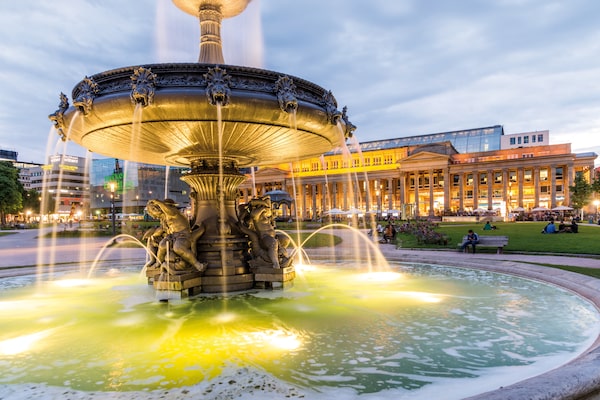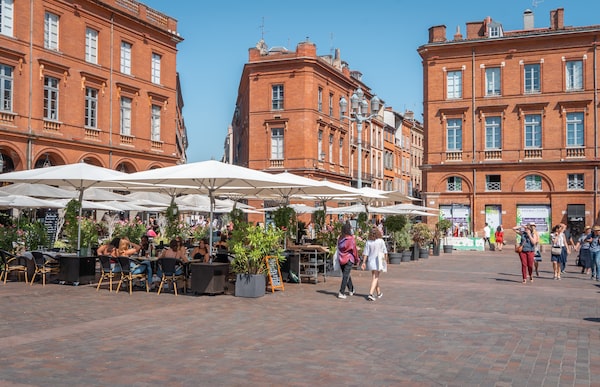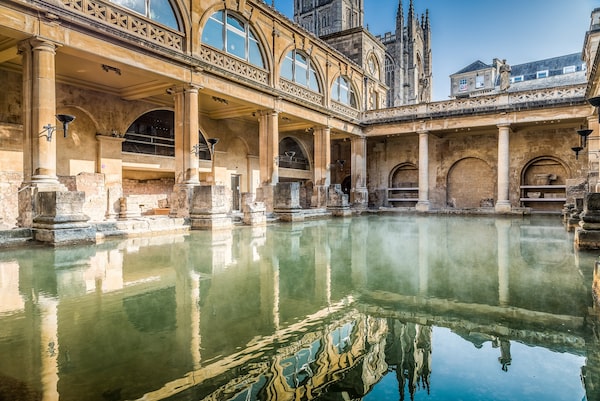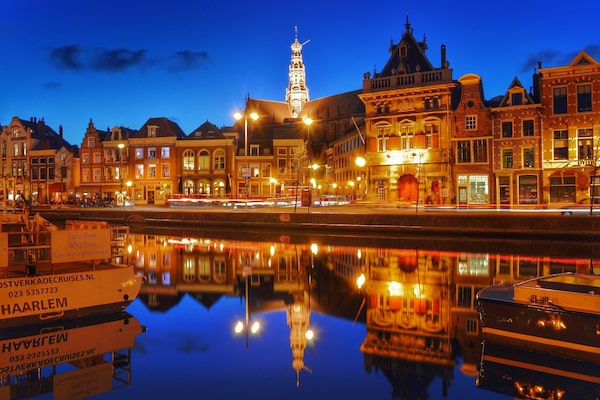
Shlossplatz, a public square in the heart of Stuttgart, is home to the 18th-century New Palace, the historic Old Palace, the Königstrasse shopping street and the glass box-like Kunstmuseum Stuttgart contemporary art museum.Handout
While Berlin, Paris, London and Amsterdam often top European travel wish lists for Canadians, why not consider alternate destinations, like Stuttgart, Toulouse, Bath and Haarlem, which offer similar experiences on a smaller scale. Plus, travelling to these locales provides the chance to explore a lesser-known region, always good for a different vibe and travel bragging rights.
Love Berlin? Try Stuttgart
What may first catch your eye in Stuttgart are the steep hills covered in neat rows of vines that surround the city.
There are 22 wineries in Stuttgart, a city of about 650,000 located southwest of Berlin in the state of Baden-Württemberg. Many of the vineyards are accessible by city buses and hiking trails, making it easy to sample aromatic white Rieslings or red varietals like Trollinger and Blaufränkisch in hilltop tasting rooms that overlook the city. If the shop is closed at the family run Diehl Winery, get a bottle of Cool Diehl white blend from the vending machine, which also dispenses cheese and crackers.
As fall approaches, restaurants, winemakers and retailers set up stalls for the Weindorf – the annual Stuttgart Wine Festival that celebrates the region’s vintners.
“When I think of Stuttgart, the Wine Village comes to mind,” says Anja Brokjans, Toronto-based director of the German National Tourist Office. She says the most beautiful squares in the city centre are transformed for the 10-day event, which runs from Aug. 28 to Sept. 8, 2024.
“The Stuttgart Wine Village has been held since 1974 and has become an absolute favourite among Stuttgart residents and wine lovers alike,” says Brokjans.
Local wines pair well with the regional Swabian dishes, like generously sized maultaschen dumplings stuffed with ground meat, spinach and onions. Squiggly spätzle noodles are also a favourite, often served with gravy or soupy stewed lentils. A tall glass of Stuttgarter Hofbräu Pilsner beer is also a great pairing.
Still hungry? Stuttgart has 17 Michelin-starred restaurants. Or visit the 5,000-square-foot art nouveau-style Stuttgart Markthalle, where vendors sell everything from seasonal delights like white asparagus, to pastries, cured meats and seafood.
To get to Stuttgart, Canadians can fly to Frankfurt and board a train at the airport. It takes three hours or less to get there.
Gearheads will feel their hearts zoom in this automotive capital, home to both Daimler AG and Porsche. The Mercedes-Benz Museum, which wows with its sleek design, has more than 160 vehicles on display, from vintage to futuristic research models. Admire dozens of race cars at the equally impressive Porsche Museum and try getting behind the wheel with interactive exhibits.
Soccer fever arrives in June as Germany hosts for the month-long slate of 2024 UEFA European Football Championship matches. Some will be played in Stuttgart Stadium.
In central Stuttgart, wander around the Schlossplatz central square, home to the 18th-century New Palace, the historic Old Palace, the Königstrasse car-free shopping street and glass box-like Kunstmuseum Stuttgart contemporary art museum.
A short U-bahn (metro) ride away, Eun Young Yi’s monolithic cube design for the Stuttgart Stadtbibliothek city library is worth a look for its beautifully simple, all-white interior, where staircases leading between open floors are a key part of the interior design.
Design lovers will adore the 1927-built Weissenhof Estate, an exhibition by international architects tasked with building affordable, well-designed housing and apartments for a showcase of modern architecture. It was led by German architect Ludwig Mies van der Rohe, a name that’s familiar to Torontonians as the designer of the Toronto-Dominion Centre.
Eleven structures survived Second World War bombings, including two houses designed by Le Corbusier and Pierre Jeanneret, which are now the Wiffenhof Museum. Then walk around the neighbourhood and admire the visionary dwelling designs which are still inhabited by lucky residents.

With 11 Michelin-starred restaurants, Toulouse, known as la ville rose (the pink city) is a good swap for Paris for exploring gastronomic delights.Rémi Deligeon/Agence d’attractivité de Toulouse Métropole
Love Paris? Try Toulouse
Paris isn’t the only French city to live la vie en rose. Toulouse earns its nickname la ville rose (the pink city) for the rosy-coloured bricks that give a romantic sunset glow to many of its buildings.
“Toulouse has quite an interesting Renaissance heritage, with the small narrow medieval streets and the pink brick buildings, which really is a special touch and a special colour,” says Marine Esch, Metropolitan Toulouse press relations officer.
The pace here is slower than in Paris and the people of this southwest region are famous for their friendliness, Esch says. In fact, according to a recent poll, Toulouse was voted France’s most polite and welcoming city, she adds.
“If you’re looking for the buildings, go to Paris,” says Esch. “If you’re looking for the warm inhabitants, come to Toulouse, because it’s what Toulouse is all about.”
Founded 2,000 years ago on the banks of the Garonne River, Toulouse is the fourth-largest city in France and the capital of the wine-growing Occitanie region. Plus, it’s a gateway to the well-preserved medieval walled city of Carcassonne, about 80 kilometres away.
Wander the narrow streets and squares of Toulouse to admire some of the 142 mansion houses within the city’s Remarkable Heritage Site zone. The city is small; it takes about 30 minutes to walk across the historic heart. But you’ll want to stop often to eat. Toulouse is a good place to explore gastronomic delights, with 10 Michelin-starred restaurants.
To get an idea of how seriously people take food here, wander through the Victor Hugo Market, the largest covered market in France. Pick up picnic ingredients or eat your purchases on the spot with a glass of wine while standing at wine barrels situated around the market hall.
Restaurants are located on the first floor of the market. Sample local specialties including cassoulet, made with garlicky pork Toulouse sausages. Toulouse says it is the birthplace of the comforting stew, although other nearby towns also claim the distinction.
Walk off lunch with a stroll along the peaceful Canal du Midi or in one of the city’s 160 parks and gardens. There are more than 100 different botanical species on display in the Jardin des Plants botanical garden.
Museums include the Bemberg Foundation Museum in the 16th-century Renaissance palace l’Hôtel d’Assézat, which is set to reopen in early 2024, after a lengthy renovation. Les Abattoirs Musée is in a 19th-century slaughterhouse and has a collection of modern and contemporary art. And dive into the sex lives of flora and fauna at the Muséum de Toulouse, where the exhibition Sex-Appeal, the Scandalous Life of Nature runs until July.
As the heart of the European aerospace industry, Toulouse has plenty to engage airplane buffs at the Aeroscopia Museum. Get up close with dozens of legendary aircraft, including the Concorde, the first supersonic passenger jet. Or experience a virtual moon landing at the Cité de l’espace space flight discovery centre.
“Come to Toulouse to have like a smaller city, but which still has some cool things and good food, good wines and really friendly people,” Esch says.

Roman baths are part of a museum complex in central Bath, the only city in the U.K. to be designated a UNESCO World Heritage Site in its entirety.Visit Bath
Love London? Try Bath
From first-century Romans seeking a steaming soak to today’s fans of the gossipy Regency-era Netflix romance Bridgerton, the small city of Bath has been drawing people to this picturesque Avon River valley spot for centuries.
It’s about 90 minutes by train from London or take a connecting flight from Canada to Bristol Airport, about 40 minutes away from Bath.
Aquae Sulis, the settlement that became Bath, was founded by the Romans in the first century with the discovery of the mineral hot springs. The rebuilt Roman Baths are now part of a museum complex in the compact centre of Bath. While there’s no bathing allowed there now, the neighbouring Thermae Bath Spa is a contemporary-style relaxing retreat that uses the same hot mineral waters from the underground springs that once fed the Roman baths. The showpiece glass-walled rooftop pool has expansive views of the city.
The well-heeled and well-known of the 18th-century came to soak in and sip the mineral waters, then parade in the gardens to ensure they made the society pages. Georgian-era neoclassical Palladian buildings constructed from honey-coloured Bath Stone limestone added to the graceful ambiance of the town. The curved row of 30 terraced homes of the Royal Crescent, the elegant residences of Queen Square and the magnificent ring of large townhouses that form the Circus contribute to Bath’s reputation as one of the most beautiful cities in the U.K.
It’s among the 11 elegant European sites included on UNESCO’s list of the Great Spa Towns of Europe. It’s also listed as a UNESCO World Heritage Site.
The waters are still drawing people here. Today, the buzzwords are spa culture and wellness, says Ritushri Dhankher, communications and travel trade executive with Visit Britain in Toronto.
Smaller Dutch cities and towns are truly like hidden gems. It’s more of a Dutch immersion. Less kitschy, more genuine.
— Hans Pellikaan, graphic artist
“Bath has been upcoming for a few years now,” says Dhankher. “It’s definitely known as the original wellness destination, especially in Britain, because of the famous Roman baths and also the thermae baths.”
Alongside day spas and elegant spa hotels in Bath, the town’s architecture is also a contributor to a feeling of well-being, says Dhankher. The town was designed to make even a casual stroll feel like an event, a place built for optimal relaxation and the pleasures of being in a beautiful place.
“Everything seems very al fresco,” Dhankher says. “Everything is for you to experience and take in and enjoy the richness of it and I think that’s what makes Bath very memorable.”
The city’s historic sites, shopping streets and gardens can easily be explored on foot. Drop in at No.1 Royal Crescent for a look at life in Bath during the late 1700s, including the new “Georgrobe” dressing room, where fans of Bath-filmed series Bridgerton and Queen Charlotte can don Regency-style costumes for a photo op in front of a pop-art style Bath mural.
Or play dress-up Jane Austen-style at the Jane Austen Centre. The writer lived in the city from 1801 to 1806 and set two of her novels here – Northanger Abbey and Persuasion. Sun bonnets and shawls are de rigueur during the Jane Austen Festival, held in Bath each September.

The medieval city of Haarlem, less than half an hour’s train ride from Amsterdam-Centraal, offers everything from lively Michelin-starred restaurants, pumping nightclubs and cutting-edge galleries to peaceful evening strolls along the picturesque Spaarne River.John Post
Love Amsterdam? Try Haarlem
It’s easy to see why Haarlem has been dubbed the mini-Amsterdam. It has all the gable-front brick houses, narrow canals and tiny lift bridges to give visitors the Dutch experience they crave, but on a smaller scale.
It takes about 16 minutes on the notoriously punctual Dutch Railways system to travel to Haarlem by train from Amsterdam-Centraal. With more than 145 trains daily, some visitors opt to stay in Haarlem and head to Amsterdam for day trips. Trains also connect with popular cities including Leiden, Gouda and The Hague, although you may never want to leave this peaceful city.
“I would choose Haarlem over Amsterdam 10 times out of 10 because this is the way I remember my country. Smaller Dutch cities and towns are truly like hidden gems,” says Dutch-born Victoria graphic designer Hans Pellikaan. “It’s more of a Dutch immersion. Less kitschy, more genuine.”
Cobblestone streets lead to Haarlem’s heart, the Grote Markt square. Restaurants and bars line the sides, making it a lively area at lunchtime and sunset. The square is also the site of a Saturday farmers’ market, where freshly made stroopwafel cookies are served hot from the waffle iron, the caramel filling oozing out the sides.
The 16th-century cathedral, known as Grote Kerk or St.-Bavokerk, dominates Grote Markt square and is just as showy inside, thanks to the famed Christian Müller organ. It takes up the entire rear wall of the cathedral, standing 30 metres tall, with mahogany red wooden details and dozens of gilded statues. George Frideric Handel and a 10-year-old Wolfgang Amadeus Mozart once played the instrument.
While the Anne Frank House is one of Amsterdam’s most-visited museums, Haarlem also honours the memory of occupants of a famous safe house at the Corrie ten Boom Museum. The ten Boom family risked their lives to hide Jews and members of the Dutch Resistance from the Nazis in their home during the Second World War. It’s estimated the family saved the lives of 800 people.
The free Teylers Museum, the oldest museum in the Netherlands, is a weird and wonderful dive into scientific instruments, machines, fossils, science and all manner of curious and fascinating displays.
The Frans Hals Museum is an excellent museum dedicated to the works of Golden Age artist and one-time resident Frans Hals in a circa-1609 former almshouse.
Almshouses were originally homes for elderly single men, paid for by wealthy patrons – in an early form of social welfare. The men were considered incapable of seeing to daily domestic tasks, so they lived as a group. Not so the single senior women living in the charitably funded hofjes, where they found homes and community. The charming linked tiny houses face onto the kitchen gardens with a water pump in the centre.
About 20 of the hofjes still stand. Small doors lead from the street into these peaceful, private areas. Pick up a free walking tour map at the tourism bureau at the city hall in the Grote Markt.
The tranquillity of the hofjes extends to Haarlem’s quiet, canal-side residential streets in the evenings. People put chairs outside their front doors, or fold-down benches anchored to the house, and enjoy a glass of wine or a coffee at the end of the day.
“Imagine sitting outside on the stoop in the dim evening light, greeting locals and hearing the occasional bike rattling along the cobbles,” Pellikaan says.
“One aspect of Haarlem that cannot be underestimated is its peacefulness at night.”